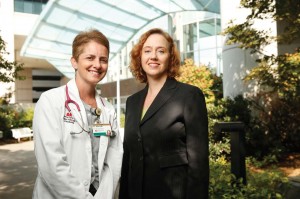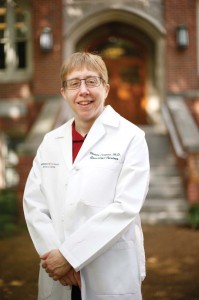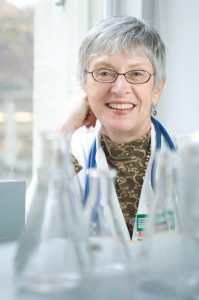Missing the Mark
There is a vaccine that prevents cancer. Why are so few getting it?
December 18, 2014 | Nancy Humphrey

Illustration by Richard Mia
Since the Pap smear debuted in the 1950s to detect pre-cancerous changes in a woman’s cervix, mortality rates for cervical cancer have dropped by 70 percent, according to the American Cancer Society, making the simple collection of cells from the opening of the cervix perhaps the biggest success story in the history of cancer screening.
After several decades with annual cervical screening in place, efforts turned to prevention. The early 1990s brought about the discovery that nearly all cervical cancers are caused by certain types of the human papilloma virus (HPV), which is primarily spread through sexual contact. So in 2006 there was great excitement among health care professionals when the Food and Drug Administration (FDA) licensed Gardasil, the first HPV vaccine. First aimed only at girls, it was licensed to include boys in 2009, to protect against genital warts.
But the truth is, for a vaccine that prevents cancer, the vaccination rates are surprisingly low. The Centers for Disease Control and Prevention (CDC) says that only 37.6 percent of girls ages 13-17 received all three recommended doses of HPV in 2013. And the rate for boys is even lower—13.9 percent.
These rates are considerably below the U.S. Department of Health and Human Services Healthy People 2020 goal of having 80 percent of 13- to 15-year-old girls fully vaccinated by 2020.
Tennessee’s rates are even lower than the national average. Only 35.9 percent of 13- to 17-year-old girls in Tennessee received the three recommended doses of the HPV vaccine in 2013, compared to the state with the highest rate, Rhode Island, where 56.5 percent of girls in this age group were fully vaccinated for HPV.
Many believe the vaccine has become too tied up in issues of sexual activity and not associated enough with what it is—a method of preventing a cancer that kills more than 4,000 of the 12,000 women diagnosed with cervical cancer in the United States each year. In developing countries, where Pap smear use is not widespread, the mortality rates are much higher.
“We as providers aren’t comfortable talking to our patients and their parents about it, so we don’t suggest it in the same way we suggest other childhood vaccines like Tdap (tetanus, diphtheria, pertussis) and meningitis,” said Kris Rehm, M.D., associate professor of Clinical Pediatrics and director of the Division of Hospital Medicine at Monroe Carell Jr. Children’s Hospital at Vanderbilt. “But we shouldn’t differentiate them. We should be able to talk about HPV not as a virus that is spread by sexual activity, but as a virus that causes cancer.”

Kris Rehm, M.D., left, and Pamela Hull, Ph.D., are leading efforts to increase HPV vaccine rates. Photo by John Russell.
Two HPV vaccines are currently available in the United States—Bivalent HPV2 (Cervarix) and Quadrivalent HPV4 (Gardasil). Both protect against HPV types 16 and 18, which cause 70 percent of cervical cancers and the majority of other HPV-associated cancers. HPV4 also protects against HPV types 6 and 11, which cause 90 percent of genital warts. Either vaccine can be given to girls to prevent cervical cancer. HPV4 is also given to boys to prevent genital warts and to decrease transmission of HPV strains that cause cervical cancer in girls.
The American Academy of Pediatrics recommends the three doses of HPV vaccine be given at age 11-12, before the onset of any sexual exposure. The second shot is recommended 1 month after the first; a third shot, 6 months after the first. The vaccine is also recommended for men up to 21 and women up to 26 who did not receive the vaccine when they were younger, said Rehm, who is also president of the Cumberland Pediatric Foundation.
“HPV infection is not rare. Luckily, not all of them are the cancer-causing strain, but it’s a pretty powerful thing that we have something to prevent that,” she said.
HPV can also cause cancers in the back of the throat, most commonly in the base of the tongue and tonsils, in an area known as the “oropharynx.” These cancers are called “oropharyngeal cancers.” Studies in the U.S. have found that about 7 percent of people have oral HPV. But only 1 percent of people have the type of oral HPV that is found in oropharyngeal cancers (HPV type 16).
HPV vaccines that are now on the market were developed to prevent cervical and other less common genital cancers. It is possible that HPV vaccines might also prevent oropharyngeal cancers, but studies have not yet been done to determine if they do.
Getting the word out
The vaccine’s “suboptimal uptake” and a recommendation from the President’s Council Panel of the National Cancer Institute that achieving widespread HPV vaccination is “one of the most profound opportunities for cancer prevention” has prompted a group of faculty members at Vanderbilt University Medical Center to try to raise awareness about the HPV vaccine among providers, parents and patients.
The effort needs to start with providers, Rehm said.
Pamela Hull, Ph.D., a medical sociologist with Vanderbilt’s Division of Epidemiology in the Department of Medicine, believes that many providers might assume that parents don’t want to discuss the HPV vaccine or would decline it for their child, when in fact, focus groups conducted by Hull and colleagues at Meharry Medical College and Tennessee State University (TSU) show that parents want to be asked.
“If you ask providers what they think parent perception (of HPV vaccine) is, they assume parents have a low interest. But actually there’s a gap in what the parents’ interest is and in what providers assume their interest to be,” Hull said.
The CDC even has a Web page aimed at providers with recommendations about how to talk to parents about the HPV vaccine. One recommendation is to talk about Tdap, meningococcal meningitis and HPV vaccination with equal emphasis.
Vanderbilt has teamed with Meharry and TSU in a social marketing campaign targeted for 11- to 12-year-old African-American children, who along with Hispanic girls, have a higher incidence of cervical cancer and mortality. The campaign has a community advisory board of parents and their daughters.
The campaign, “Bug Your Doc—Get 3 Shots,” addresses the need for Tdap, meningitis and HPV vaccines at age 11-12. “It can be counterproductive to promote the HPV vaccine by itself, because parents who see it as different from other vaccines are more hesitant,” Hull said. “Parents who see it as just another vaccine are more accepting. By instinct, as parents, we all want to protect our children.”
The team’s focus groups with undecided mothers and adolescents identified two sub-segments: the Undecided/Ready if Offered segment who would readily accept the HPV vaccine if given the opportunity and a health care provider recommendation; and the Undecided/Skeptical segment who needed more in-depth information to allay concerns about vaccine safety, mistrust of drug companies and recommended age.
Hull said that completion of the three-shot series is also an issue with many families. Tdap and meningococcal meningitis require only one shot at the pre-teen visit, although meningitis requires a booster at age 16-18. But parents believe that reminders from the health care provider might help. Statistics show that African-American and Hispanic girls are least likely to finish the series once it’s started.
Hull also has personal experience. A pediatrician didn’t bring up the vaccine at her daughter’s 11-year-old visit, so Hull asked. Her daughter was given the first dose, but the doctor, the nurse who gave the shot, and the person at the check-out desk all failed to tell Hull and her daughter that there were two follow-up shots.
“I’ve heard that from other parents as well,” she said. “It’s certainly not intentional, but it’s a matter of dropping the ball, of one assuming that the other is going to tell the parent,” she said.
“Parents want reminders, even if it’s just an appointment card. But they also like phone, email or text reminders because people get busy and they just forget.”
In another effort to get the word out, Hull’s division teamed with Rehm and the Cumberland Pediatric Foundation on an HPV informational session hosted at the Nashville Zoo, targeted toward parents with children under age 18.

Photo by John Russell
Another joint Vanderbilt/Meharry project is targeting four community health centers serving underserved patients to see if provider intervention raises the rate of HPV vaccine.
At two of the sites parents are asked about the HPV vaccine, and if their child has not received the vaccine, an informational video is shown during the wait for the health care provider. Parents are also given an informational sheet with a list of possible questions about the vaccine they may want to ask the provider during their visit to help initiate a discussion and recommendation. Usual care (no video or list of questions) is provided at the other two sites.
Saying yes
Ukela Moore and her daughter, Danielle, were participants in one of Hull’s HPV focus groups. Danielle has gotten all three doses of the vaccine.
“We learned about the vaccine and everything we know thus far about the virus from the group,” Moore said.
“I believe I’m like most moms. I want to protect Danielle from anything and everything that may harm her,” Moore said. “When I learned that certain strains of HPV could develop into cancer but it could be prevented with three doses that are available at her pediatrician’s office, the decision was no different from going to get the polio vaccine or the flu shot.”
Her family history also reinforced that decision. In 1954 Moore’s mother came in contact with the highly contagious polio virus. It attacked her legs leaving one of them smaller. She traveled from Culleoka, Tennessee, to Meharry for several surgeries throughout her childhood and still has residual effects.
“I would recommend that parents look into the research, statistics and data concerning the HPV vaccine and arrive at the conclusion that they (and their families) are comfortable with,” Moore said.
She also thinks it’s a good example to set for younger generations.
“When we as parents make our health and our children’s health a priority, our children will be more likely to do so as well when they move forward to adulthood.”
An absolute triumph

Marta Crispens, M.D. Photo by John Russell.
The development of a vaccine to prevent cervical cancer less than two decades after the discovery that HPV causes cervical cancer is an “absolute triumph of translational science,” said Marta Crispens, M.D., associate professor of Obstetrics and Gynecology.
“We understand a lot about how HPV causes the cancer, and we haven’t translated that into treatments, but we’ve translated it into something potentially better—a way to keep from getting cancer in the first place. That’s absolutely huge.”
But Crispens said it’s important to note that even a vaccinated woman can get cervical cancer since there are subtypes of cervical cancer that are not caused by types 16 and 18 (which the vaccine is designed to prevent).
“So for that reason, it’s very important that even vaccinated women realize that they need to follow cervical screening guidelines. The vaccine isn’t a reason not to get your Pap,” Crispens said.
If caught in its early stage, survival rates for cervical cancer are 80 to 90 percent. But like other cancers, as the stage goes up, survival rates go down.
Crispens said it’s also important to note that although it’s known that the HPV vaccine prevents HPV infection that causes the most common cervical cancers, confirmation won’t be available for decades.
“We know that the vaccine is enormously effective in preventing HPV infection with 16 and 18. That’s been shown clearly, but since the average duration from time of infection with HPV to high grade dysplasia is about 10 years and the average time from high grade dysplasia to cancer is about another 10 years, it’s going to take us 10 years to find out if we’ve affected dysplasia rates and 20-30 years to figure out if we affect cervical cancer rates. I probably won’t still be practicing when they figure this out.”
Sticking to the schedule?

Kathryn Edwards, M.D. Photo By Susan Urmy.
Kathryn Edwards, M.D., Sarah H. Sell and Cornelius Vanderbilt Professor and director of Vanderbilt’s Vaccine Research Program, said since the HPV vaccine is both effective and safe it’s “disturbing” that the uptake is so low. For comparison, about 86 percent of U.S. teens 13-17 receive the Tdap vaccine and 87.7 percent, the meningitis vaccine.
She, like Hull, believes that having to have three shots in six months may be impeding the completion of the vaccine series.
Edwards and Todd Callahan, M.D., MPH, associate professor of Pediatrics, have conducted a study through Vanderbilt’s Vaccine Treatment and Evaluation Unit to see what happens to the vaccine’s effectiveness if the second and third doses are given at longer intervals. They have completed the study, but the results are not yet known.
“But we hope to be able to say if you get behind, it’s still OK, just get the other doses as soon as you can and the vaccine will work just as well.”
Edwards said that it also needs to be determined whether, like the meningitis vaccine, booster doses of the HPV vaccine are needed in adulthood.
“Many parents believe that their daughter doesn’t need a vaccine when she’s 11 or 12 for something that’s sexually transmitted, but the vaccine works best if you give it at a younger age,” Edwards said. “And there’s no data to suggest that by getting the vaccine, you’re promoting a promiscuous lifestyle. The HPV vaccine isn’t a license for rampant sexual activity, but by and large, most people are going to have some sort of sexual activity in their life.”
